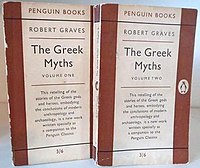The Greek Myths
 First editions | |
| Author | Robert Graves |
|---|---|
| Country | United Kingdom |
| Language | English |
| Publisher | Penguin Books |
Publication date | 1955 |
| Media type | Print (hardback & paperback) |
| Pages | 2 volumes (370 pp, 410 pp) |
The Greek Myths (1955) is a
Each myth is presented in the voice of a narrator writing under the
Contents
Graves interpreted
The Greek Myths presents the myths as stories from the ritual of all three stages, and often as historical records of the otherwise unattested struggles between Greek kings and the Moon-priestesses. In some cases Graves conjectures a process of "iconotropy", or image-turning, by which a hypothetical cult image of the matriarchal or matrilineal period has been misread by later Greeks in their own terms. Thus, for example, he conjectures an image of divine twins struggling in the womb of the Horse-Goddess, which later gave rise to the myth of the Trojan Horse.[2]
Pelasgian creation myth
Graves's imaginatively reconstructed "Pelasgian creation myth" features a supreme
In the soil of
Also included are the Homeric, Orphic and Olympian creation myths, as well as two "philosophical" creation myths.
Olympian creation myth
Graves offers his interpretation of “The
Reception
Graves's retellings have been widely praised as imaginative and poetic, but the scholarship behind his hypotheses and conclusions is generally criticised as idiosyncratic and untenable.[6]
Ted Hughes and other poets have found the system of The White Goddess congenial; The Greek Myths contains about a quarter of that system, and does not include the method of composing poems.[7]
The Greek Myths has been heavily criticised both during and after the lifetime of the author. Critics have deprecated Graves's personal interpretations, which are, in the words of one of them, "either the greatest single contribution that has ever been made to the interpretation of Greek myth or else a farrago of cranky nonsense; I fear that it would be impossible to find any classical scholar who would agree with the former diagnosis". Graves's etymologies have been questioned, and his largely intuitive division between "true myth" and other sorts of story has been viewed as arbitrary, taking myths out of the context in which we now find them. The basic assumption that explaining mythology requires any "general hypothesis", whether Graves's or some other, has also been disputed.[8] The work has been called a compendium of misinterpretations.[9] Sibylle Ihm refers to Graves's "creative mishandling of the Greek myths."[10] Robin Hard called it "comprehensive and attractively written," but added that "the interpretive notes are of value only as a guide to the author's personal mythology".[11] The Disraeli scholar Michel Pharand replies that "Graves's theories and conclusions, outlandish as they seemed to his contemporaries (or may appear to us), were the result of careful observation."[12]
Graves himself was well aware of scholarly mistrust of The Greek Myths. In a letter to Ava Gardner, he wrote:
I am not a Greek scholar or an archaeologist or an anthropologist or a comparative mythologist, but I have a good nose and a sense of touch, and think I have connected a lot of mythical patterns which were not connected before, Classical faculties will hate me, and I will get a lot of sniffy reviews.[when?][15]
Editions
- In two volumes (Penguin Books nos 1026 and 1027), 370 pp. and 410 pp. respectively, with maps in each volume and an index in Vol. 2; Harmondsworth: Penguin Books, 1955; reprinted with amendments 1957; revised edition 1960; numerous reprintings
- in one volume (Penguin Classics) 793 pp, 2012. ISBN 978-1101580509
References
- ISBN 0-374-50493-8
- ^ Graves, Robert (1996). The Greek Myths. Folio Society. p. 629.
- ^ ISBN 978-0-14-001026-8.
- ^ "Books: The Goddess & the Poet". TIME. 18 July 1955. Archived from the original on 6 June 2008. Retrieved 5 December 2010.
- ^ a b Graves, Robert (1955). The Greek Myths: Volume One. Penguin Books Inc. p. 31.
- JSTOR 1086782. "the paraphrases themselves are wittily written, and take a twinkly delight in promoting extra-canonical alternative versions of familiar stories." Nick Lowe, "Killing the Graves Myth", Times Online, 20 December 2005. Times Online
- ^ Graves and the Goddess, ed. Firla and Lindop, Susquehanna Univ. Press, 2003.
- ^
Robin Hard, bibliographical notes to his edition of H.J. Rose, The Routledge Handbook of Greek Mythology, p. 690, ISBN 0-415-18636-6, quoted.
G.S. Kirk, Myth: Its Meaning and Functions in Ancient and Other Cultures, Cambridge University Press, 1970, p. 5.
ISBN 0-520-02389-7Richard G. A. Buxton, Imaginary Greece: The Contexts of Mythology, Cambridge University Press, 1994, p. 5.
ISBN 0-521-33865-4Mary Lefkowitz, Greek Gods, Human Lives
Kevin Herbert: review of TGM; The Classical Journal, Vol. 51, No. 4. (Jan. 1956), pp. 191–192.
JSTOR 3293608. - ^ As quoted in: Pharand, Michel W. "Greek Myths, White Goddess: Robert Graves Cleans up a 'Dreadful Mess'", in Ian Ferla and Grevel Lindop (ed.) (2003). Graves and the Goddess: Essays on Robert Graves's The White Goddess. Associated University Presses. p.183.
- ISBN 9780198738053.
- ^ Hard, Robin. The Library of Greek Mythology. Oxford University Press, 1997. p. xxxii.
- ^ Pharand, Michael W., 2003 "Greek Myths, White Goddess: Robert Graves cleans up a 'dreadful mess'", in Ian Ferla and Grevel Lindop (ed), Graves and the Goddess: Essays on Robert Graves's The White Goddess, p. 188. Associated University Presses.
- JSTOR 704652.
- ^ For other criticisms of the accuracy of Graves' retellings, see for example, Nick Lowe, "Killing the Graves Myth", Times Online, 20 December 2005. Times Online. Lowe called the work "pseudo-scholarly".
- ISBN 9780198738053.
